- News
- Reviews
- Bikes
- Accessories
- Accessories - misc
- Computer mounts
- Bags
- Bar ends
- Bike bags & cases
- Bottle cages
- Bottles
- Cameras
- Car racks
- Child seats
- Computers
- Glasses
- GPS units
- Helmets
- Lights - front
- Lights - rear
- Lights - sets
- Locks
- Mirrors
- Mudguards
- Racks
- Pumps & CO2 inflators
- Puncture kits
- Reflectives
- Smart watches
- Stands and racks
- Trailers
- Clothing
- Components
- Bar tape & grips
- Bottom brackets
- Brake & gear cables
- Brake & STI levers
- Brake pads & spares
- Brakes
- Cassettes & freewheels
- Chains
- Chainsets & chainrings
- Derailleurs - front
- Derailleurs - rear
- Forks
- Gear levers & shifters
- Groupsets
- Handlebars & extensions
- Headsets
- Hubs
- Inner tubes
- Pedals
- Quick releases & skewers
- Saddles
- Seatposts
- Stems
- Wheels
- Tyres
- Health, fitness and nutrition
- Tools and workshop
- Miscellaneous
- Tubeless valves
- Buyers Guides
- Features
- Forum
- Recommends
- Podcast
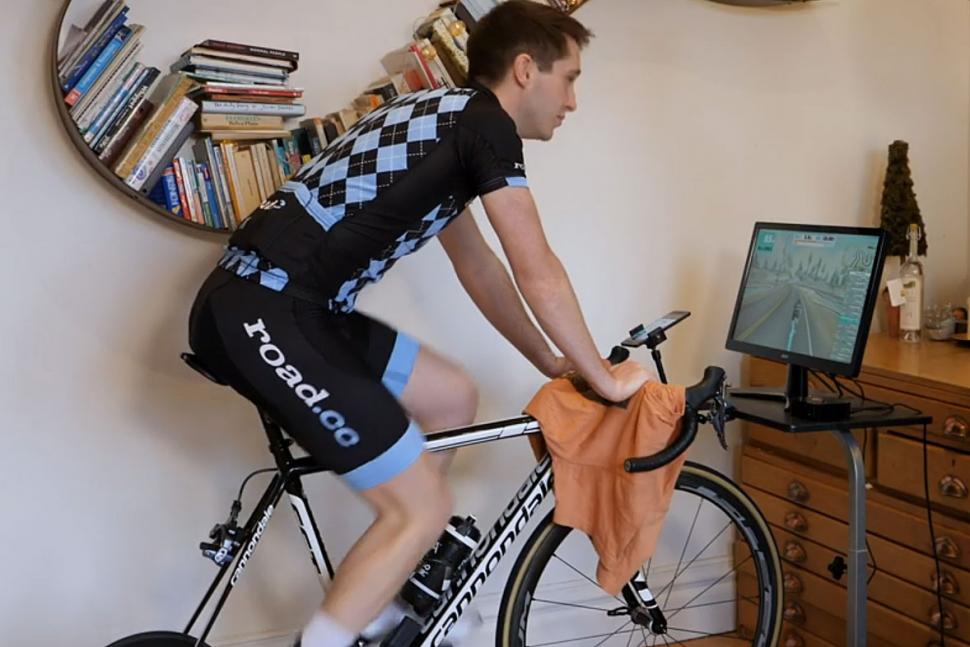 Indoor training (Liam from Zwift video) 2
Indoor training (Liam from Zwift video) 2Cycling through lockdown: 3 top techniques to get or stay fit at home
With lockdown still around, plenty of you will be taking precautions such as working from home and social distancing. The latest rule for exercising is that you must only ride solo, with other members of your household or with one person from another household (only if on your own)—once per day. The government guidance document also says: "This [outdoor exercise] should be done locally wherever possible, but you can travel a short distance within your area to do so if necessary (for example, to access an open space)". Firing up Zwift and training indoors is proving to be the most reliable, easiest and safest option for many...
Read more: Cycling dos and don'ts in a time of pandemic
Read more: What the latest lockdown laws and guidance mean for you and cycling
Nobody wants to lose fitness, but the first thing to stress, although we're sure you know this already, is that you shouldn't train when you're ill or get back on the bike until you're fully recovered. Given that Covid-19 is extremely easy to catch, you should factor in the possibility that you are going to get ill too and not make that illness worse by over-doing it in Watopia, or by doing interval sessions when you shouldn't.
Read more: Dealing with illness and coming back from it
Read more: Recovering from long COVID - a cyclist's guide
All that said, given the length of time that most healthy adults take to recover from Covid-19 there's also going to be decent periods when you're not ill, or recovering – what follows is for those times.
Read more: 13 of the best smart home trainers
Read more: 6 reasons why using a home trainer is the best way to get fit
British Cycling are regularly updating their COVID-19 guidance with what the current government guidelines means for riders, clubs, events, facilities, coaches and others involved in our sport. Cycling UK is also keeping a live document on the best practice to follow in line with the regulations.
Despite the ever-changing situation, there are plenty of options for staying fit – and still competing – while social distancing. Here are our top tips for staying fit and healthy.
1 Try Zwift (and other indoor training systems)
The most obvious way to continue training and racing, whether you’re self-isolating or social distancing, is on Zwift. The online app was booming before the coronavirus; now the roads of Watopia will be rammed with races and virtual group rides. Luckily you can just ride straight ‘through’ other cyclists without crashing!
If you haven’t discovered Zwift yet, in a nutshell it’s an app that runs on all the latest operating systems that allows you to ride your bike online in a virtual world. Its most compelling feature is the ability to ride with (or compete against) other people across the world. You can just hook up with your mates or you can train and race at any level.
Read more: How to get in to e-racing — the lowdown on online bike races
Video: A Zwift set up for every budget
With these platforms being so engaging and motivating—thanks to in-game achievements—it can be easier to commit to exercising on a regular basis and significant fitness gains can be made. But be careful not to overdo it...Find out about the gamification of cycling platforms, exercise addiction and overtraining here.
To use Zwift, you put your bike in a smart turbo trainer linked with a computer, tablet or phone, and you choose your online course. Popular ones include Zwift’s own imaginary Watopia, the Yorkshire World Championship course, London, New York Central Park and a mountainous Innsbruck parcours. It’s a cross between gaming and training, with your legs controlling your performance. Check out our guide to getting started on Zwift, and how to ride in road.cc kit so your avatar can look as dashing as the riders in the pics above...
Other indoor training apps
Zwift is the most popular indoor training app, and in terms of its graphics and rider experience it is arguably the most immersive... but it’s by no means the only one. Most smart trainers come with a proprietary training app – think Tacx, Bkool. Rouvy (formerly CycleOps) and the gym bunny’s favourite Technogym.
Zwift vs TrainerRoad: Which is best for you?
Meanwhile, third-party indoor training apps such as TrainerRoad and The Sufferfest have their loyal followers. TrainerRoad’s biggest appeal is the vast number of workouts and training plans it provides. There are a staggering 1,000+ workouts for all tastes and requirements. You can also follow a training plan (there are 100+) with plans for every type of cyclist, covering early season base work to race preparation.
Sufferfest might not provide a virtual world to cycle around, but the real pro race footage, music and storylines are very compelling and provide a great distraction and keep you pedalling hard.
Review: The Sufferfest Indoor Training App
The company has also developed what it calls Four-Dimensional Power, or 4DP for short, which it reckons goes beyond FTP in using four metrics to help personalise the workouts to your exact needs. And now, as well as actual training, Sufferfest is branching out by offering yoga, mental toughness and strength training programmes aimed at the needs of cyclists.
Want more training app suggestions to keep you occupied? Check out our guide to 13 of the best
Smart trainers
If you want to use any of the above training apps, you’ll need a smart trainer with a wireless connection that will pair with your device, via Bluetooth or ANT+ FE-C. The two main types are direct drive and wheel-on. With the former you remove the rear wheel and clamp the bike into the trainer so that it drives the trainer’s own cassette. With the latter, clamp the bike rear wheel and all to a more traditional-looking turbo where it drives a roller.
Read our buyer's guide to the best smart trainers
Direct-drive turbos are more expensive but feel more solid, are generally more accurate, have a higher resistance so that you can climb, sprint or do low-cadence/high power intervals where you’d get wheel slip with a wheel-on model. On the downside direct-drive trainers are much heavier and more awkward to move since they typically weigh around 20kg.
Try this FTP booster session
Even if you don’t have a smart turbo trainer you can still make the most of indoor training. Coach Simon Beldon, who works with Matt Bottrill Performance Coaching, suggests this FTP-boosting session (if you're not acquainted with your Functional Threshold Power yet, check out our guide to what it is and how to find out yours)...
25 mins warm-up L1-L2, cadence 100 RPM (revolutions per minute)
---
20 mins: 3mins @ FTP/2 mins @ sweetspot, cadence @ 80-90 RPM (keep the variation of efforts until the 20mins is complete)
---
10 mins recovery – L2, cadence 100 RPM
---
20 mins – 3mins @ FTP/2 mins @ sweetspot, cadence @ 80-90 RPM (keep the variation of efforts until the 20mins is complete)
---
10 mins recovery – L2, cadence 100 RPM
---
20 mins – 3mins @ FTP/2 mins@ sweetspot, cadence @ 80-90 revs (keep the variation of efforts until the 20mins is complete
---
5 mins recovery
2 Do off-bike exercises
If you’re suddenly increasing your indoor training time, it’s essential to include some off-bike exercises at the same time, as Laurence Plant, clinic director at the Henley Practice, explains: “Turbo training generally is not as comfortable as outdoor riding, because the bike is fixed. As such, pressure and postural stresses build up. Saddle discomfort is magnified, as is shoulder and neck discomfort and lower back. On the road you’re continually adjusting your posture and shape even if you’re not realising it, which alleviates those postural stresses.
“On the turbo you can drills like alternating which hand you take off the handlebars to make sure your core still activates. If you’re on the hoods try to unweight one hand without changing your upper body posture. Do single-leg pedalling drills, trying to keep it smooth. Here you’re combining hip flexor activation with your downstroke firing smoothly.
“Off the bike you have to ramp up a bit of mobility work. Open up your hip flexors, glutes, quads, dominant muscles around the lower body. That will take the pressure off your lower back. A lot of people focus on stretching hamstrings, but a lot of us feel as though we have tight hamstrings because the hip flexors and quads are pulling the pelvis forward. Because the pelvis is being pulled forward, it puts tension on the hamstrings. Cyclists get very tight hip flexors and very tight quads. If you’re social distancing, working from home and going straight from the turbo back to your laptop, it’s double compounded.
“To stretch hip flexors, go to the bottom position of a lunge, then really scoop the front of your pelvis up using your abdominals. You should feel the stretch on the front of your hip. Tight hip flexors are one of the primary causes of low back pain, particularly in the athletic population.
“Try a thoracic extension. If you picture an aerodynamic cyclist you’ve got a little bit of a humped back, but you don’t want it to get too curved. Lying lengthwise down a foam roller, the end on the base of the skull and – if you have a 90cm roller – your tailbone on the other end. Put your arms out in a cross position. That basically opens up your pectorals as your arms relax and it opens up your thoracic spine and ribcage. It’s a very easy one. The more classic one is where you put the foam roller across your back. Rather than parallel to your spine you go perpendicular and that increases your thoracic extension. That way you end up with better thoracic mobility so that you don’t end up shaped to your desk or your chair.
“Cyclists should always be getting a lacrosse ball into their glutes or doing a pigeon – one knee crossed up underneath you. It’s really good for opening up your glutes and sacroiliac joints. It’s an age-old yoga stretch, but a real back-saver. Your glutes are the powerhouse of your leg drive. And any cyclist not foam-rolling their quads is going to develop issues around the hip, because they won’t be releasing out their iliotibial band and their vastus lateralis, which is the lateral aspect of the top. Or, if they don’t manifest at the top, the problems will manifest around the knee.
“Those are the five or so exercises cyclists should be doing the stretching world. There are a whole host of strengthening exercises cyclists can do, but that’s all down to how dedicated somebody is to being even better."
Check out NHS-approved Meglio for the 90cm foam roller and lacrosse ball... and if you have even more time to ease, strengthen and relax your tired muscles, check out our series on yoga for cyclists.
3 Pay attention to nutrition
“You cannot boost your immune system through diet and no specific food or supplement will prevent you from catching COVID-19/coronavirus,” says the British Dietetic Association. “Good hygiene remains the best means of avoiding infection.”
The BDA recommends paying attention to maintaining a healthy, balanced and varied diet to support immune function that includes copper, folate, iron, selenium, zinc and vitamins A, B6, B12, C and D.
However, people who live in Northern latitudes are often deficient in vitamin D in the winter because we don't get enough sunshine to make the body's required amount. There's also some evidence that vitamin D might have a modest preventative effect on respiratory infections.
In a short discussion paper on the topic, The Lancet concludes: "it would seem uncontroversial to enthusiastically promote efforts to achieve reference nutrient intakes of vitamin D … there is a chance that their implementation might also reduce the impact of COVID-19 in populations where vitamin D deficiency is prevalent; there is nothing to lose from their implementation, and potentially much to gain."
In addition to keeping up with the latest advice for cyclists, do read the NHS advice on coronavirus, and the government’s latest information about social distancing... stay safe and see you on the other side!
Latest Comments
- lonpfrb 3 hours 30 min ago
PCCs are an attempt to provide Legitimacy by connecting an elected representative to the oversight of Policing. Thus voter surveys to sample...
- ktache 4 hours 18 min ago
Mine tend to get knocked by the chaining of the bicycle, then fall off later. To be found next time I use the light. Some crushed.
- ktache 4 hours 21 min ago
I'm guessing not that very manoeuvrable either.
- Simon E 5 hours 34 min ago
That is a pity, Malcolm had a great reputation and spent a lot of time posting his no-nonsense advice gained over many years on Bikeradar....
- Rendel Harris 5 hours 47 min ago
It's a mark of how weak your pompous pontificating is that you're forced to make up things I never said in order to try to defend your "look at me...
- SaveTheWail 7 hours 29 min ago
'I was so lucky that I was doing the speed limit' (!) http://www.bbc.com/news/articles/c17d598vj0qo
- Blackthorne 8 hours 50 min ago
It's mentioned in benefit #2 in the article...
- levestane 9 hours 2 min ago
Pneu ballon and hookless rims are back, I still have some 27" Birmalux rims in the shed somewhere.
- brooksby 10 hours 51 min ago
Well yes, but it is the holidays
- Rendel Harris 12 hours 3 min ago
Thank you for that excellent forensic analysis, I couldn't figure out where I'd gone wrong! Must drink more coffee and put on glasses before trying...
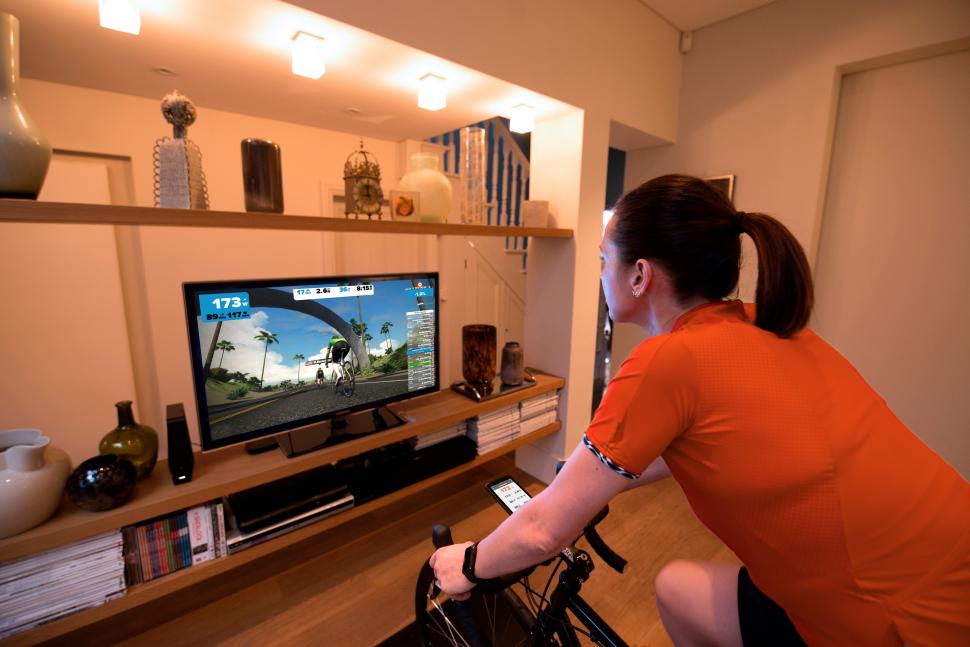
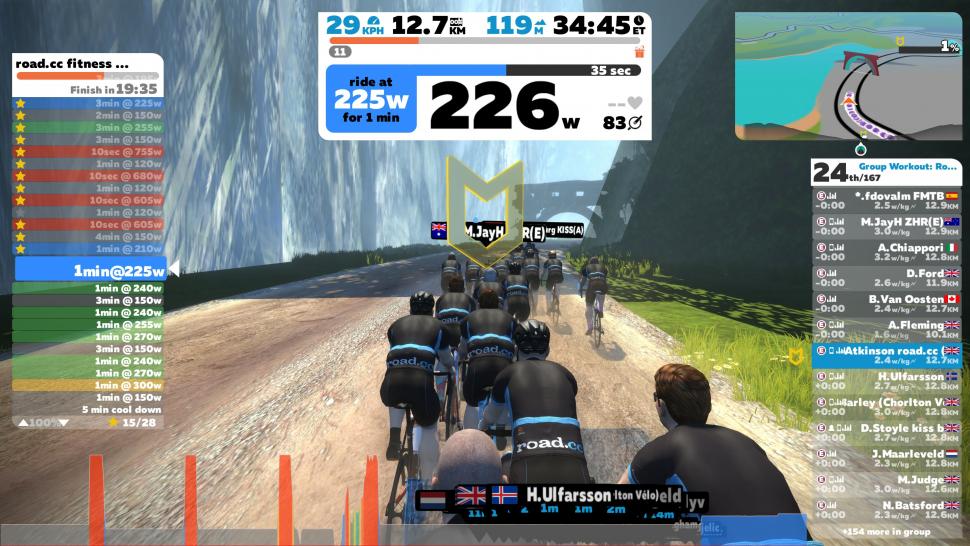
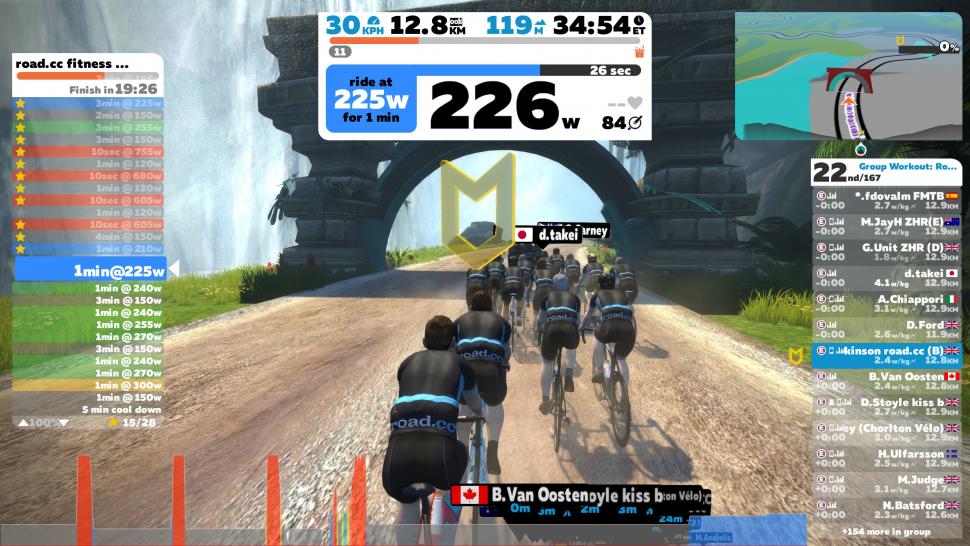
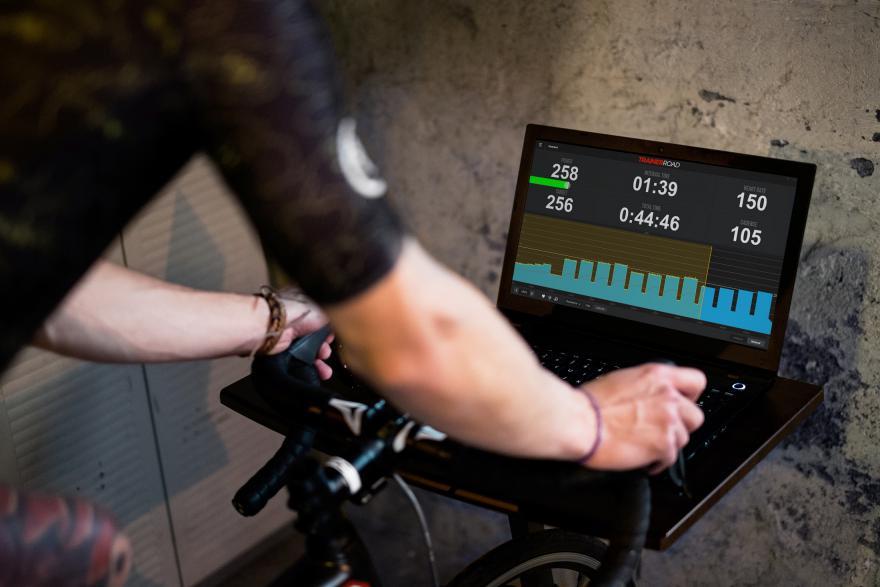
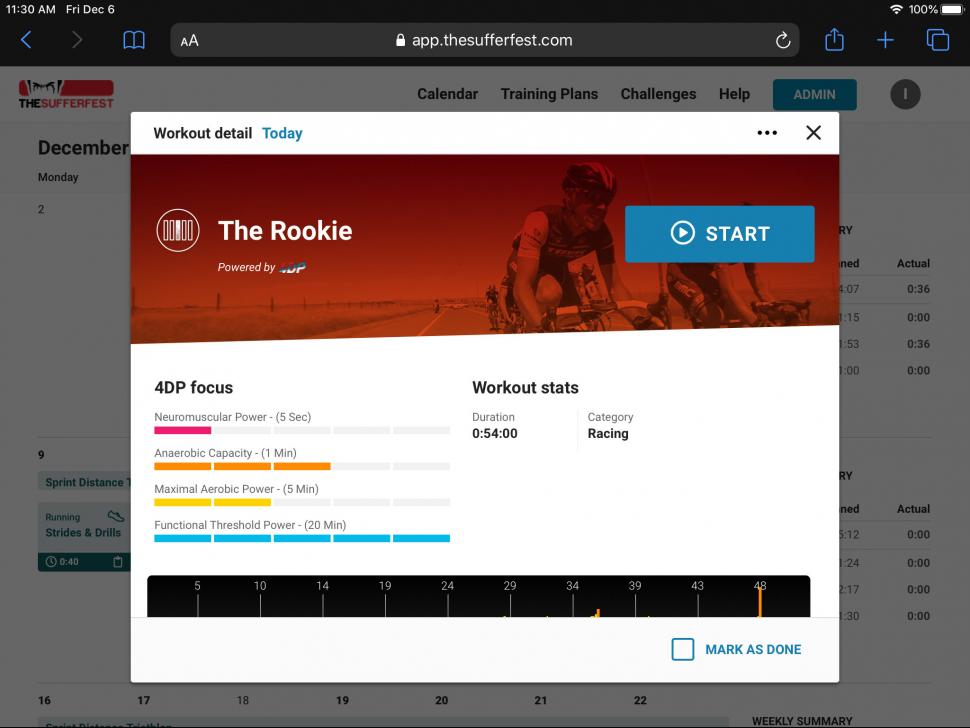
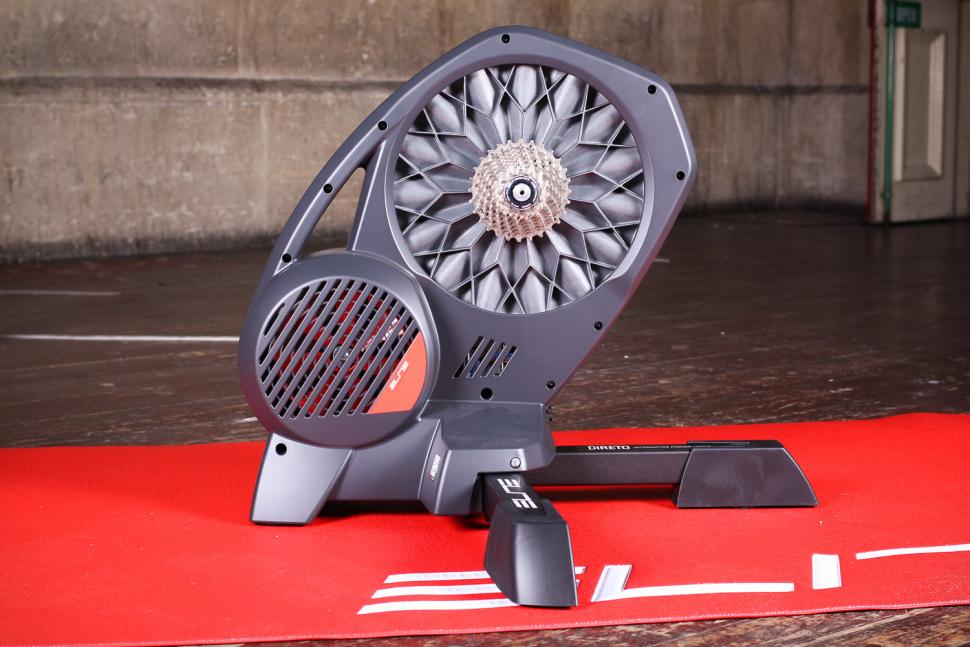
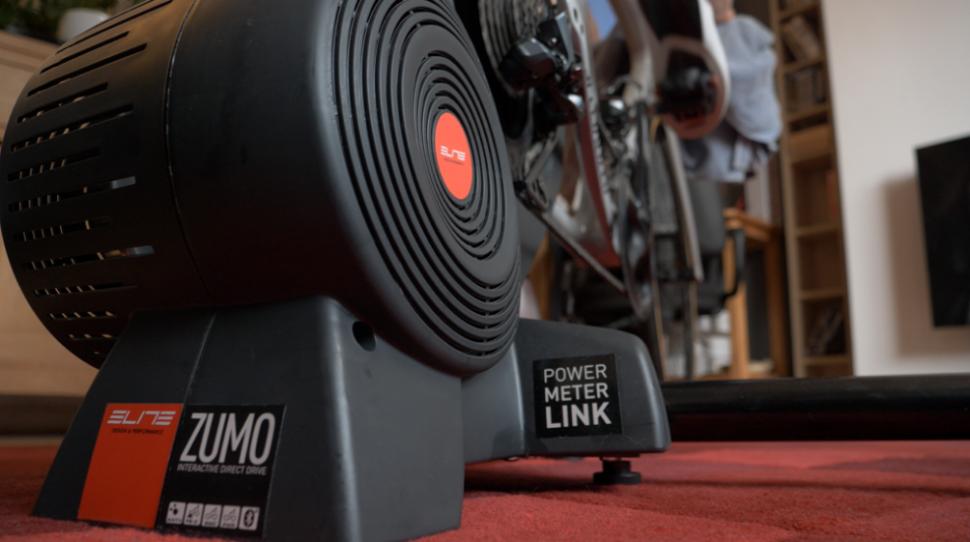
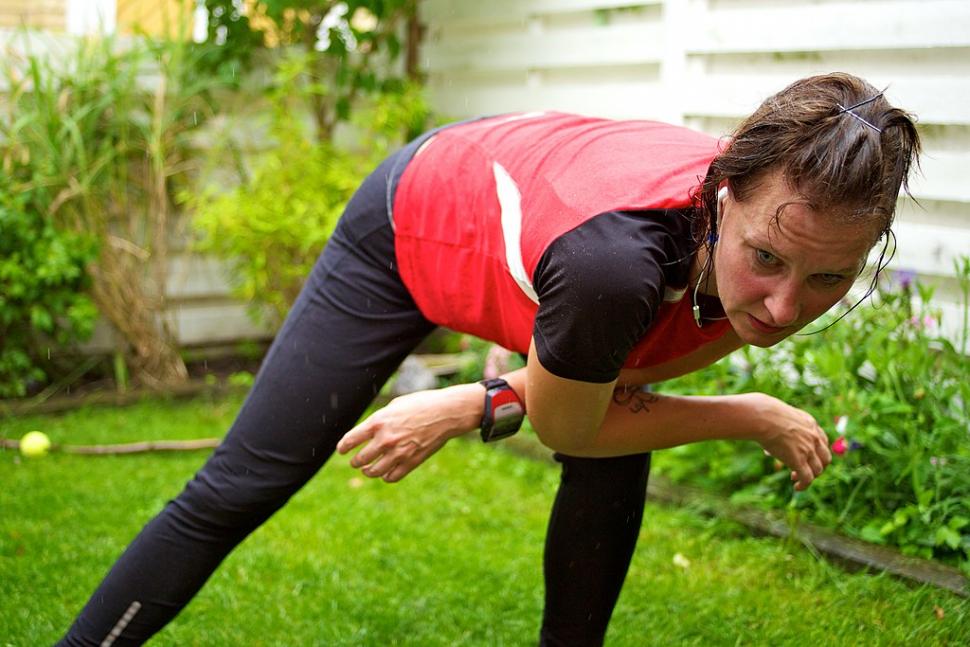


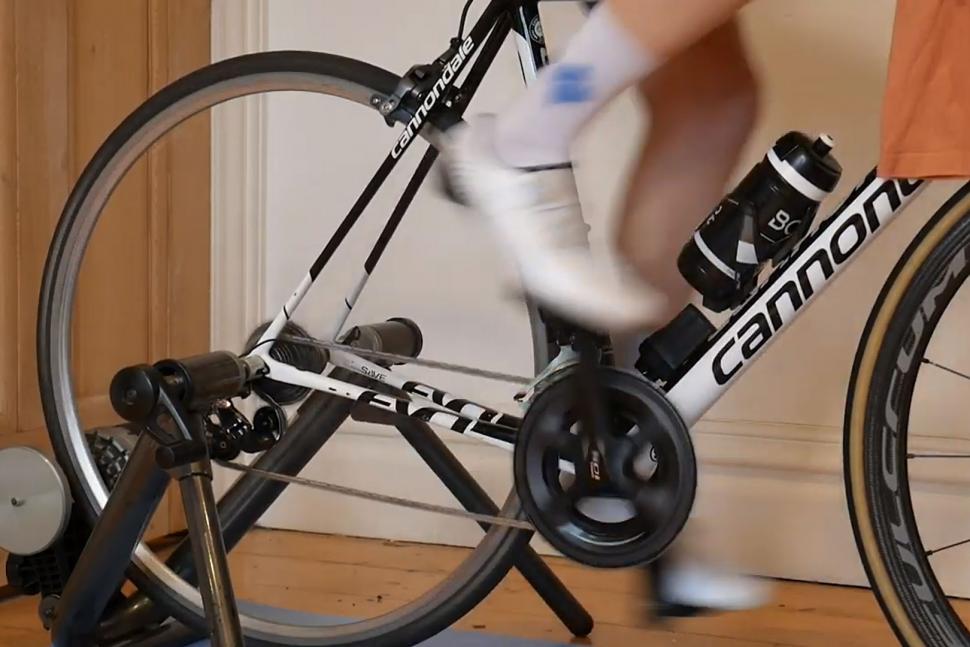
Add new comment
22 comments
I think I prefer Toyah's approach
https://www.youtube.com/watch?v=khkKfMotNoI
Its fascinating reading the 9 month old comments, knowing now what we didn't know then...
I know this post has been chopped around a few times - the reference to pasta running out in the shops seems a little dated - so forgive me if I've missed the point here, roadcc, but this article is not about being a lockdown cyclist is it? Nutrition and cross-training aside it's largely about which home trainer to buy (it's a Zwift it seems), which is not the same thing at all.
+1
Unless you're one of those people who actually prefers to sit on a bike indoors why wouldn't you want to get out and ride - even on your own? In 2020 I haven't set world-beating records, but I'm confident I've got in more miles than in any of the previous eight years, largely because I was furloughed.
On menacing motorists - since the beginning of the first lockdown I've had precisely three close passes, which works out at one per 450 miles. I can live with that. (On top of that figure is the miles travelled to get away from my house - I don't start my Garmin until I'm well away from home). I do feel sorry for those I read about on this forum, and on others, who seem to be caught up in a daily battle, but I don't think it's the experience of most cyclists - other than commuters, maybe.
Yesterday I had hoped to go a bit further, but still managed a decent 100km ride - the first third in the fog - without going barmy. I took a flask, some grub and stuff in a rack bag and stopped for drinks and the odd photo every now and again. There were a fair few cyclists about, and an extraordinary number of people walking in the countryside. I've never seen so many.
When the roads are too icy to ride on I intend to get out my old barbells in the garage and do a bit of weight training. Mind you, that's been my intention for the past ten or so winters. Maybe this year will be different...
Or just open your door and push your bike outside, get on it and ride. There you go saved yourself a load of money and getting your exercise, doesn't it feel good breathing in all that fresh air.
Why not just ride outside? Yes, it is a bit harder at this time of year, but that's just a question of layering up...
Because Outside can't be packaged up and sold like as a bicycle-riding app, and Outside doesn't pay commissions.
Cos it is really easy to buy flour and eggs...
Not usually one to comment but please road.cc adopt some form of responsible journalism. Yes, self isolation and working from home for many will allow more training time. However articles like this on "getting fit" are going to encourage a lot of people to flirt with overtraining, especially the competitive nature of zwift. Overtraining as we all know puts extra stress on your immune system leading people to be more susceptible to picking up viruses when they inevitably have to leave the house to restock the cupboards. You mention that nutrition can't boost the immune system, but you also need to stress that too much training can weaken it.
Most people with enough dedication for a turbo are already ahead of the general population in aerobic fitness, with less underlying health conditions, and will probably only suffer mildly from covid 19. Just maintain this fitness!
Now isn't the time to be flogging yourself to improve your stats, it's a time to remain active for physical and mental wellbeing. There will be no events in the 2020 season, so what are you "training" for?( I hope I'm wrong but realistically this is likely to be the case).
TO EVERYONE WHO READS THIS PLEASE USE COMMON SENSE AND ACCEPT SOME SOCIAL RESPONSIBILITY AND KEEP YOURSELF HEALTHY, NOT OVERTRAINED AND RISK SPREADING THE VIRUS BY PICKING IT UP YOURSELF.
From a frontline emergency services worker (with an NHS wife) who has accepted that my key target events as a first year veteran will have to wait until next year, and will probably be working to protect the public seven days a week when the true magnitude of this pandemic is realised in the near future.
Nowhere does the article suggest over-training or training while ill. Nowhere.
We've changed the original headline which was intended as a mildly jokey reference to being confined indoors and wanting to keep fit on your bike. We work on the assumption that the people who read road.cc are intelligent enough adults to get that and to know that training while ill or recovering from illness is not a sensible thing to do. We've also added a paragraph at the start of the piece to spell that out
But it's also true that given the weeks and possibly months that social distancing measures and probably even total lockdowns are likely to be in place a lot of people are going to be stuck indoors who aren't ill.
I appreciate your concerns on this one and we've tweaked the article to reflect them but to echo a phrase from your response to it - now isn't the time for… a lot of things and one of them is knee-jerk reactions - so we won't be taking it down, not that you're asking us to.
Living in the Scottish Highlands 'social distancing' is pretty much a way of life. I can leave my house and pick any number of routes never to see another soul. Buying toilet roll on the other hand! 🤷♂️
Tony, thanks for the response and amendments. However I also never mentioned training whilst ill, and never meant to imply the article suggested it. Perhaps there is some confusion over the term self isolation and social distancing, as not everyone self isolating is sick or has been sick, they are just taking more extreme measures of distance.
My criticism was more about what the article fails to mention, namely rest and recovery (other than the bit about mobility and stretching). Numerous historic training articles on this site have stressed the importance of small increments in training and adequate recovery to prevent over training. The article doesn't mention it at all, and if any training article in the history of road.cc should do it's this one. At this moment in time it is borderline dangerous in not doing so. A lot of people are suddenly going to be presented with a lot more opportunity to train, and searching the internet for ideas and guides. At the same time we are at risk of contracting perhaps the worst mass virus since the Spanish influenza. Many will train wisely, but many will not, and suddenly ramp their volume and/or intensity up to risk injury and a weakened immune system. This particularly applies maybe to the panic buyers of turbos also mentioned on the site, some of whom may be new to structured interval training. Ordinarily I couldn't care less if people overtrain or articles fail to mention a key component of fitness, periodization and recovery, but as a media publication with a far reaching readership some responsibility needs to be taken to look out for the health of its membership. To assume all readers are intelligent and will make the right decisions is to hide behind ignorance.
I also wanted to stress to fellow athletes to consider the need to treat the forthcoming months as a stay at home training camp, and if they choose to do so then do it wisely so it doesn't harm them or loved ones, or inadvertantly someone elses. It's a given this virus will affect the majority, but we've all got to make personal sacrifices to make the spread as gradual as possible so the NHS doesn't get overwhelmed and people can live who might otherwise be left to die.
Another sports site I regularly read has just put out an article titled "What athletes need to know about immune health", which covers many of the things that should also be in this article. An example of a now predominantly online publication looking after the welfare of its readers.
I wish everyone well for the forthcoming months.
Hi JN46, is this the article you were talking about? It's an interesting read https://www.triathlete.com/nutrition/what-athletes-need-to-know-about-im...
Tony, there's lots of great content on road.cc but I think you're missing the point JN46 is making:
So I think the article needs a warning not just about not exercising during periods of illness (which you've done already) but also about overtraining/over-exertion and the risks it presents.
Yes Cdean, that's the one. A further warning within this article about healthy people not training too hard is important. A lot of people are clueless about training zones and are just going to keep tapping away in their grey zone racking up too much intensity, especially on zwift racing. This shouldn't become a debate on training types and the science of polarized training, but I'm already seeing people I follow on strava doing double training days they wouldn't ordinarily do, and in fact have never done before.
London hospitals are starting to be overwhelmed: https://www.theguardian.com/uk-news/2020/mar/20/london-hospitals-struggl...
"“I had to turn my operating theatre into a four-bed ICU and we are intubating two or three patients every eight hours or so,” said a doctor at one London hospital. An intensive care unit consultant at another hospital said: “The place is in panic stations trying to cope safely with the numbers of patients coming out of our ears.”"
"One warned that it was only a matter of time before hospitals in London ran out of intensive care beds and had to start making difficult decisions about which patients could go on a ventilator."
"Speaking of the Northwick Park critical incident, a senior manager at another London trust said it raised serious concerns about the ability of the capital’s hospitals to deal with the surge in patients. “Given we’re in the low foothills of this virus, this is fucking petrifying,” the official told the Health Service Journal."
Jesus what a needless article and a ridiculous response.
A) WE ARE NOT LOCKED DOWN. YOU CAN EXERCISE OUTSIDE WITHOUT RESTRICTION. RIDE OUTSIDE AND WALK OUTSIDE WHEREVER AND WHENEVER.
B) How many people would train to the point of literal exhaustion indoors AND then also manage to carelessly get the virus. You've probably got more cyclists having actual good old accidents visiting the NHS than appearing with turbo trainee induced coronavirus. More people will catch coronavirus at the supermarket.
You missed that this was about the first lockdown where we were given the impression we should not go far and only once a day. Plus you had the overzealous Derbyshire police tracking people with their drone to shame them for being out in the hills.
Lol I got caught out by raveygravey necroposting and didn't read the date. I'll get caught out by Lshaped cranks again next.
Lol I got caught out by raveygravey necroposting and didn't read the date. I'll get caught out by Lshaped cranks again next.
Well the article seems to have been brought to the fore again which is fair enough given the 4 week lockdown.
Shame the traffic levels are not back to march volumes.
and Im still seeing people claim we are only "allowed" 1hr exercise in this lockdown, and yet the parks were absolutely packed today, with no social distancing going on at all.
The traffic is weird it feels like its dropped in volume on key routes, yet you get to the tourist destinations and the amount of cars parked everywhere, you think well how did they get here then, plus Ive probably had more close passes since lockdown 2.0 began, than I had in the whole of lockdown 1, so definitely not like March at all.
No sign of the lockdown round my way. Expected some quieter roads today but they were very busy with essential journeys... Wasn't expecting the roads to be as quiet as during the first lockdown, but if anything it was busier than recent weeks. Got the full treatment as well today - aggressive horn use, shouting abuse, close passes, speeding, forced off the road by oncoming traffic and overtakes before blind bends. Really quite depressing.
No sign of the lockdown round my way
Agreed. In North Lancashire people were just driving around more than usual. This is the new non-lockdown lockdown.